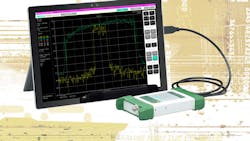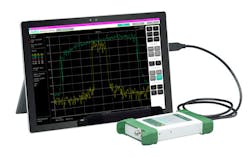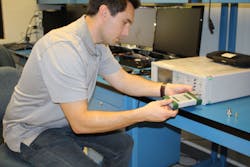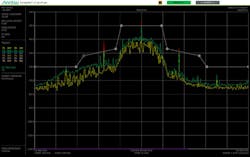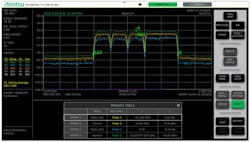This file type includes high resolution graphics and schematics when applicable.
Millimeter-wave frequencies offer untapped bandwidth for many different applications, for those able to deliver practical wireless solutions in frequency bands such as 60 and 77 GHz. A major part of achieving those solutions includes the capability to test performance levels at such high frequencies, both for a device under test (DUT) and its operating environment. Fortunately, making measurements at millimeter-wave frequencies just became much easier with the introduction of the Spectrum Master MS2760A family of portable spectrum analyzers (Fig. 1) from Anritsu Co.
Performance is impressive, with fast sweep speeds (11 s to sweep across a 110-GHz frequency range), wide dynamic ranges (100 dB to 110 GHz), and broad frequency ranges. Six different models cover ranges of 9 kHz to 32 GHz through 9 kHz to 110 GHz. What might be even more astounding is the size of these “ultraportable” instruments—these spectrum analyzers are no larger than a cell phone. They make use of a USB connection to a PC, laptop, or tablet, and its display screen to show measured results.
The millimeter-wave spectrum analyzers can be brought to a DUT, rather than the other way around (Fig. 2). USB-powered MS2760A spectrum analyzers are almost like having a test laboratory in a pocket, and they represent the types of measurement tools that will help deliver millimeter-wave wireless technology to the masses.
As mentioned, six available Spectrum Master MS2760A models offer frequency coverage starting at 9 kHz for each and topping out at 32, 44, 50, 70, 90, and 110 GHz (with the 90-GHz version offered for locations where export licenses are required for frequencies above 90 GHz). Size is not the only “small” thing about these instruments—their cost allows multiple instruments to be purchased for the price of a single, larger benchtop instrument.
While millimeter-wave wireless applications are not about to become commodity items overnight, the millimeter-wave spectrum is gradually becoming more crowded. These frequencies have been in use in military applications, and for some time commercially in automotive electronic safety systems—notably at 77 GHz in collision-avoidance radar systems. The coming application of millimeter-wave bands for Fifth-Generation (5G) cellular wireless communications systems is expected to truly unleash the use of available wide bandwidths in support of the many communications and entertainment functions to be offered by service providers.
Testing these higher-frequency millimeter-wave-frequency systems will require suitable test equipment, including spectrum analyzers with not only sufficient frequency range but also acquisition bandwidth. In addition, other performance parameters will come into play, such as frequency sweep speeds, when large segments of bandwidth must be scanned for potential operating environment issues (e.g., interference and coexistence with other high-frequency signal sources and their harmonic signals).
The Spectrum Master MS2760A ultraportable spectrum analyzers incorporate a number of patented technologies to squeeze the measurement capabilities of a full-sized, benchtop spectrum analyzer into those palm-sized packages, including shockline nonlinear transmission line (NLTL) technology. This enables the construction of receiver circuitry covering frequencies from audio through millimeter waves with excellent amplitude accuracy and with amplitude flatness that remains typically within ±1 dB, even for a near-110-GHz frequency range.
Signal power tends to decrease with increasing frequency, with conventional mixer-based technologies exhibiting losses that increase with rising frequencies. The nonlinear characteristics of the NLTL circuits enables them to achieve flat amplitude response over such wide frequency spans.
The consistent frequency response and wide dynamic range of each Spectrum Master’s internal receiver circuit boards and its transmission lines are preserved in the coaxial realm by means of a wideband planar-to-coaxial transition, terminating in different test port connectors depending on the frequency range of the particular Spectrum Master model.
For operation to 70 GHz, for example, 1.85-mm V-connectors (named for their V-band frequency range) are used. In regards to the highest-frequency model, 1-mm coaxial connectors enable connections to DUTs, antennas, and other measurement accessories operating at frequencies to 110 GHz. Models operating to 32 and 44 GHz use 2.92-mm K connectors.
Depending on the choice of frequency range, these pocket-sized spectrum analyzers are ready for high-frequency measurements in commercial, industrial, and military markets, including for automotive safety systems, military electronic-warfare (EW) systems, microwave radios, and satellite-communications (satcom) systems. The small size and versatility of the analyzers encourages production and even research environments to operate with multiple test stations.
In research, this equates to a more thorough investigation of a new design or technology. In production, it translates to more products that are ready to ship. And at millimeter-wave frequencies, the number of products expected to ship is projected to eclipse all that has come before at frequencies above 30 GHz.
In addition to the large number of production-line measurements needed to supply the hardware requirements of growing millimeter-wave applications, on-site testing (Fig. 2, again) will be essentially for qualification and maintenance of 5G wireless communications networks employing millimeter-wave frequencies. Due to the short-range propagation of millimeter-wave signals and their attenuation by buildings and other obstacles (even by people), wireless-communications coverage with millimeter-wave frequencies will require large numbers of antennas and antenna arrays and possibly multiple-input, multiple-output (MIMO) techniques for the best use of maintaining signal coverage with multiple antennas.
Having pocket-sized, battery-powered analyzers capable of characterizing such high-frequency networks and their antennas will allow 5G network technicians to bring the testbench with them. In fact, with the small size of the Spectrum Master millimeter-wave spectrum analyzers, the test instruments can be connected directly to a DUT, such as an antenna, for simplified testing. In this way, the loss (and the cost) of interconnecting millimeter-wave coaxial cables can be eliminated from the measurement setup.
The six millimeter-wave Spectrum Master portable spectrum analyzers operate with some form of controller, such as a tablet or laptop running Windows 7, 8.1, or 10. They are controlled remotely by small computer peripheral interface (SCPI) via a USB connection. The spectrum analyzers provide a number of “smart” measurements, including channel power, adjacent channel power, and occupied bandwidth.
Up to six measurement traces with individually selected detectors can be shown on the controller’s screen at once, and as many as 12 total markers positioned on the traces to display the fine details of a measurement. Various limit-line functions can be set for frequency and amplitude for upper and lower limits (Figs. 3 and 4). Sweep functions include single and continuous sweeps. In terms of amplitude, signal traces are able to be displayed in ranges of 1 to 15 dB/division, in 1-dB steps, with 10 divisions shown on the display screen.
Checking the Specs
The novelty of squeezing the essential elements of a spectrum analyzer into a package measuring just 6.1 × 3.3 × 1.1 in. (155 × 84 × 27 mm) and weighing just 9 oz. (255 g) doesn’t obscure the fact that these high-performance measurement instruments are reaching frequencies not commonly displayed. The Spectrum Master millimeter-wave spectrum analyzers provide the sensitivity, dynamic range, and sweep speeds to identify interference when it becomes a problem and to keep track of signals in frequency bands of interest, no matter how high.
They also feature the measurement capabilities and bandwidths to screen for harmonic signals from lower-frequency signals, since otherwise harmless microwave signals can produce second- and third-harmonic signal components that become problems when they fall within a target millimeter-wave frequency band.
The Spectrum Master ultraportable spectrum analyzers tune frequency with resolution of 1 kHz across their different frequency ranges. Measurements can be made with resolution bandwidths (RBWs) and video bandwidths (VBWs) from 10 Hz to 3 MHz and with sweep speeds approaching 7 s for a near-70-GHz span. Reference levels can be set from −120 to +30 dBm, with maximum safe input power as high as +20 dBm. The displayed average noise level (DANL) is typically −132 dBm from 40 to 70 GHz and −134 dBm or better for most of the frequency range below that. The DANL is typically better than −127 dBm through 110 GHz.
The analyzers operate with very good spectral purity, with typical spurious levels of −95 dBc and worse-case spurious levels of −85 dBc. Second-harmonic performance measured for a 1-GHz input signal at 0 dBm is typically −60 dBc, with maximum second-harmonic level of −60 dBc for a 1-GHz input signal at an input level of −20 dBm. The coaxial input is well matched to 50 â¦, with a typical VSWR of 1.29:1 to 12.4 GHz (18-dB return loss), 1.43:1 to 26.5 GHz (15-dB return loss), 1.58:1 to 40 GHz (13-dB return loss), and 2.10:1 to 70 GHz (9-dB return loss).
The millimeter-wave spectrum analyzers are equipped with a USB 3.0 Type C connector from which they are completely powered by the host controller. The analyzers feature an internal frequency reference with ±1-ppm/year aging rate and ±0.2-ppm frequency accuracy, as well as input/output connections for an external 10-MHz reference source. For in-field measurements, the performance levels of the spectrum analyzers apply to temperatures from −10 to +50°C. A 12-month calibration cycle is recommended for the analyzers; they ship with a three-year warranty.
Anritsu Co., 1155 East Collins Blvd., Ste. 100, Richardson, TX 75081; (800) 267-4878, (972) 644-1777
This file type includes high resolution graphics and schematics when applicable.
About the Author
Jack Browne
Technical Contributor
Jack Browne, Technical Contributor, has worked in technical publishing for over 30 years. He managed the content and production of three technical journals while at the American Institute of Physics, including Medical Physics and the Journal of Vacuum Science & Technology. He has been a Publisher and Editor for Penton Media, started the firm’s Wireless Symposium & Exhibition trade show in 1993, and currently serves as Technical Contributor for that company's Microwaves & RF magazine. Browne, who holds a BS in Mathematics from City College of New York and BA degrees in English and Philosophy from Fordham University, is a member of the IEEE.
